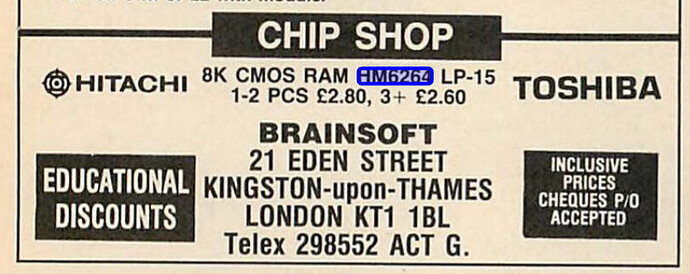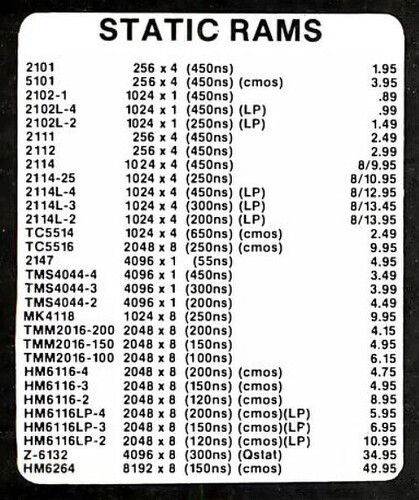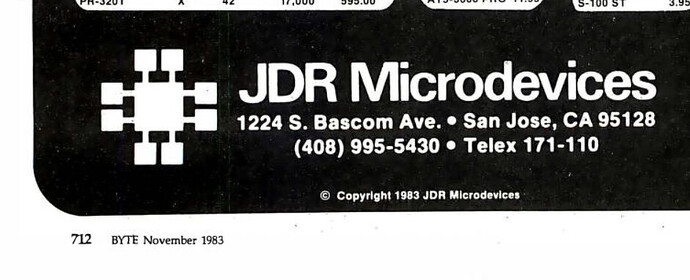In what year did the 8k x 8, fully static, unclocked CMOS RAM in the JEDEC 28-pin DIP first become available for purchase? A current example of this part is the Alliance Memory AS6C6264. I’ve tried searching, but perhaps I haven’t hit on the right terms.
Well I see 2003 mentioned on the last page; it looks like you can get in touch with them here:
Before 1986, at least… because in the summer of 1986 I built a 24kB RAM expansion for Vic-20, using three of these chips; Hitachi or Toshiba, I think.
In the January 1984 issue of Byte Magazine, JDR Microelectronics advertised the HM6262, 150ns, at $49.95.
The earliest reference I could find for the HM6264 is in the first issue of Acorn User in July/August 1982:
Odd… I’m just looking at PCW for July 1982, and I cannot see any mention of the 6264… but the 6116 was available for about £5.50.
It’s a blast looking at those old magazines… computers were much more interesting back then! (Apart from any practical concerns ![]() )
)
Practical Electronics, March 1984, ad from Watford Electronics:
![]()
Sorry about that - I re-checked and I made a mistake because Archive.org had a later issue tagged against the wrong year. .
There is a definitely a reference in Byte magazine volume 8 issue 11 (November 1983):
I do remember using these as soon as they came out, although I’m having trouble with the exact year. I later used the 32Kx8 ones (62256 and 43256) in my 6809 second processor for the Beeb and my “Acorn User” ram/rom board for the beeb. The 32K ones were a year or two behind the 8K ones. I believe they were also used internally in the battery-backed units from Greenwich Instruments (the earlier models - tall, with yellow labels, and a big pin sticking out for the R/W’ line). So if you can find the earliest sale of those, subtract a year.
Thanks! What a great group!
It’s easy to get years and transistor counts for CPUs - Wikipedia has a page with a list. But memories are much denser than CPUs (smaller chip size for an equivalent number of transistors), and it’s tough to get similar numbers for RAMs online.
Using 6 transistor static cells, an 8k x 8 (64k bit) static RAM needs 393,216 transistors for the memory array. So call it a 400k transistor part. Given that a memory array on a die is dense, perhaps the very first 8k x 8 parts used 1500nm (1.5u) technology, which happened around 1981. The die would have been large, but maybe tolerable as a stake for market share.
400k transistors in a RAM seems definitely doable in 1-micron. Wikipedia says this didn’t happen until '84, but a lot of their information is poorly sourced (and memory parts are often used as the initial vehicle for new processes). Anyway, something like that.
Even if the chip is out, it still took a year or two to get into the hands of the average Joe.
Also n K x 1 chips are harder to find as well. Ben.


